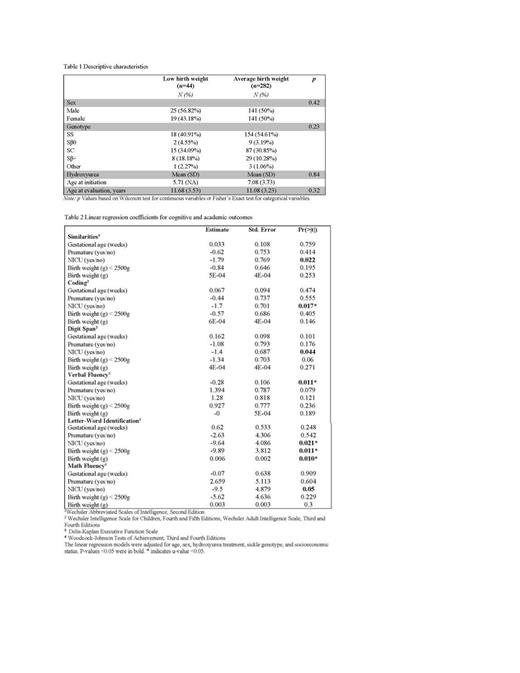Pre- and peri-natal-related risk factors are associated with slowed neurocognitive development and increased risk of learning difficulties in the general population. A recent study reported expressive language deficits were associated with preterm birth in young children with sickle cell disease (SCD) (Bills et al., 2021); however, no studies to date have examined the long-term impact of low birth weight in children and adolescents with SCD. In this cohort study, we examined associations between low birth weight (<2500g) and cognitive and academic outcomes, including formal school support services (i.e., 504 Plan or Individual Education Program), in children with SCD. Gestational age and neonatal intensive care unit (NICU) admission were investigated as covariates.
Participants were children ages 8-18 years old with SCD enrolled in the Sickle Cell Clinical Research and Intervention Program (SCCRIP), an observational cohort study of clinical outcomes in SCD. Participants received targeted neurocognitive evaluations as standard of care every 3-4 years. Performance-based neurocognitive measures were used to assess cognitive and academic abilities, including the Wechsler Abbreviated Scale of Intelligence, Second Edition; Wechsler Intelligence Scale for Children, Fourth and Fifth Editions; Wechsler Adult Intelligence Scale, Fourth Edition; Delis Kaplan Executive Function System; Conners Continuous Performance Test, Second and Third Editions; and Woodcock-Johnson Tests of Achievement, Third and Fourth Editions. Multivariable generalized linear regression examined associations between birth-related risk factors (i.e., birth weight, gestational age, and NICU admission) and cognitive outcomes, academic achievement, and need for school support services after adjusting for age, sex, hydroxyurea treatment, sickle genotype, and socioeconomic status. P-values <0.05 were considered significant. False discovery rate-adjusted p-values or q-values were calculated across the outcomes and all birth-related risk factors to correct for multiple corrections.
Of the 326 participants in SCCRIP who completed neurocognitive evaluations, 282 children had normal birth weight (HbSS/HbSβ 0thalassemia=56%) and 44 children were born with low birth weight (HbSS/HbSβ 0=45%). Birth weight groups (<2500g and >2500g) were matched for demographic and disease characteristics (Table 1). The mean age at time of cognitive evaluation was 11.16 (SD= 3.27) years and half of participants were male (51%). Low birth weight was associated with worse word reading (p=0.011; Table 2). Across all participants, admission in the NICU was associated with lower verbal reasoning (p=0.022), processing speed (p=0.017), working memory (p=0.044), word reading (p=0.021), and math fluency (p=0.05). Similarly, across all participants, earlier gestational age was associated with lower verbal fluency (p=0.011). Low birth weight and gestational age predicted need for school support services (p=0.003 and p=0.007, respectively).
History of birth-related risk factors should be considered a comorbidity for neurodevelopmental differences in SCD. Specifically, children with SCD who are born with low birth weight or admitted to the NICU are at increased risk for difficulties with processing speed, working memory, language, and academics. The need for formal school support services in SCD is associated with gestational age and birth weight.
Disclosures
Heitzer:Global Blood Therapeutics: Consultancy.


This feature is available to Subscribers Only
Sign In or Create an Account Close Modal